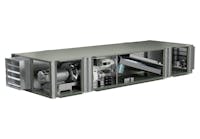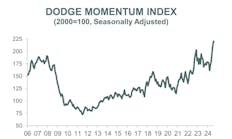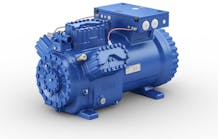If it is to accomplish its intended purpose, any damper installed in a HVAC system must be equipped with an appropriate actuator. The selection of an actuator for a specific damper requires consideration of a number of factors. This article examines the actuator-selection process. (Note: While damper actuators often go by other names, such as damper motors, damper operators, and motor packs, “damper actuator” is the appropriate terminology.)
Dampers with a wide variety of “factory-installed” actuators are available. Other dampers are supplied for “field-supplied” actuators. These actuators typically are supplied and installed by building controls contractors after a damper has been installed as part of a mechanical system.
Considerations in the Actuator-Selection Process
The following questions must be answered when selecting an actuator:
- Who will supply and install the actuator?
- Will the actuator be direct-coupled or connected using (a) linkage(s)?
- What will power the actuator? Will it be manual, electric, or pneumatic?
- What type of control action will the damper perform? Will it be two-position, modulating, or some other type of control?
- How much torque is required?
- What is the required operation time?
Who will supply and install the actuator? Damper manufacturers can supply a wide variety of actuators. Standard location of actuators on industrial dampers is external (actuators sometimes can be mounted internally in HVAC systems).
Factory installation of an actuator by a damper manufacturer usually is less expensive and the best way to ensure proper actuator sizing and installation.
It should be noted UL requires any actuator on a UL-classified smoke damper to be furnished and installed by the damper manufacturer at the time the damper is manufactured.
Will the actuator be direct-coupled or connected using (a) linkage(s)? In the past, lever arms (also called crank arms) and linkage rods were required to convert the rotary- or linear-output motion of damper actuators to the 90-degree rotation required to operate dampers. Over the years, electric actuators with 90-degree rotary output designed to couple directly to a damper’s operating shaft have become widely available. Use of these direct-coupled actuators has greatly simplified installation by eliminating the need for arms and linkages and the often-frustrating task of adjusting linkages. Using direct-coupled actuators also ensures rated actuator torque is applied directly to a damper’s operating shaft, which simplifies the matching of actuator with damper torque.
Electric actuators with many different supply voltages are available. The most common voltages are 24 VDC, 24 VAC, 120 VAC, and 240 VAC. Additionally, 360-VAC and 430-VAC three-phase actuators are available. For “fail-safe” operation, spring-return models should be specified (battery-backup systems are available for fail-safe operation).
Pneumatic industrial actuators normally require an 80- to 120-psi instrument air-supply system. An instrument air system ensures the availability of clean, dry air. If such a system already exists or is to be installed as part of a new HVAC system, then choosing a pneumatic damper actuator is a viable option.
Pneumatic actuators have greater torque than electric actuators.
A manual locking quadrant or manual gearbox operator actuator may be all that is required when a damper’s position is to be fixed after initial adjustment or changed only once or twice a year (for summer/winter changeover). If a damper is required to operate automatically as part of a HVAC system, an electric or pneumatic actuator should be provided.
What type of control action will the damper perform? Will it be two-position, modulating, or some other type of control? Before an appropriate actuator can be identified, a damper’s function in a system must be determined.
Will the damper be used to adjust airflow to a required design setting and then be locked into position?
This type of damper is called a balancing damper. Most often, it requires only a manual hand quadrant or worm-gear actuator.
Will the damper be required to open fully to allow airflow and/or to close completely to shut off airflow?
This is called two-position control. If operation is required only once or twice a year (such as for summer/winter changeover), a manual hand-quadrant actuator may be appropriate. If operation is required on a regular basis or automatic changeover is desired, a two-position actuator should be selected.
Two-position electric actuators are available in two general configurations. The simpler is two-wire spring return. Such an actuator is controlled by switching electric power on and off. Switching power on runs the actuator to its “on” position, while switching power off allows the actuator’s spring to return the actuator to its “off,” “normal,” or “fail” position. The other general configuration of two-position electric actuators requires three or more wires and a three-wire (single pole double throw) switching controller. These actuators are available in both spring-return and non-spring-return varieties.
Will the damper be required to control temperature, pressure, or airflow by moving to any position between open and closed as required by a controller?
This is called modulating or proportional control.
Actuators required to accomplish modulating control (positioning a damper to any position between open and closed) must receive a signal from a device (or controller) monitoring temperature, pressure, or some other condition in the HVAC system. A damper actuator must be compatible with the control signal generated by a controller. Most electric controllers used in commercial HVAC control systems generate a 2- to 10-VDC control signal (sometimes described as a 0-to-10-VDC control signal). Other controllers may put out a 4- to 20-mA DC signal. It is necessary to specify if the high or low end of a control-signal range should open (or close) a damper.
When supplied as modulating units, most actuators provide a method of damper feedback. This feedback can be supplied with the same 0 to 10 VDC or 4 to 20 mA of the input signal. Note that this feedback indicates the position of the actuator and not necessarily the position of the damper, should the actuator slip on the damper shaft.
Direct digital control uses digital technology to monitor conditions and signal changes required in a HVAC system. Direct digital controllers generally have provisions for an analog output, usually a choice of 2 to 10 VDC or 4 to 20 mA. Because of this feature, most direct digital controllers can operate modulating electric damper actuators directly.
Will the damper be required to return to its open (or closed) position in the event of a power failure or other emergency?
If the answer to this question is yes, a “fail-safe” actuator will be required. This will require a spring-return-type actuator to be specified (battery backup systems or capacitor options also are available).
Terminology used by the control industry can be confusing in this area. The standard terms of “normally closed” and “normally open” bear no relationship to the normal position of a damper during HVAC-system operation. An actuator is in “normal” position when power is not being supplied to a unit.
How much torque is required? A damper’s required torque is a function of its static torque and dynamic torque.
Static torque is torque that is relatively constant throughout the rotation of damper blades. Sources of static torque are:
- Bearing torque.
- Axle-seal torque (stuffing-box torque).
- Jamb-seal torque.
- Linkage torque.
- Unbalanced torque.
Dynamic torque varies with flow, pressure, and blade position. Sources of dynamic torque are:
- Velocity torque.
- Pressure torque.
- Blade-seal torque.
A damper actuator should be sized with an appropriate safety factor based on its and the damper’s functionality. Clean-air and on/off applications can operate successfully with 25-percent to 30-percent margins of safety. For modulating and dirty-air applications, safety factors of 50 percent to 200 percent should be considered.
What is the required operation time? Because industrial dampers are used in a variety of applications, their desired operation time can vary widely. Typical HVAC applications usually require 15-sec to 30-sec operation to move a damper from fully open to fully closed and vice versa. Occasionally, a process application may require operation speeds of 5 sec to 10 sec. In very special applications, such as emergency isolation, 2-sec to 3-sec—or faster—speeds have been specified. Damper manufacturers must be advised at the time of ordering that higher-speed operation is intended.
Other considerations. Normal indoor HVAC applications can be operated adequately with an actuator rated for NEMA (National Electrical Manufacturers Association) 1 areas. Applications in more exposed areas may require weatherproof or explosionproof (NEMA 4 or NEMA 7) enclosures. This will reduce the number of actuators suitable for an application and can greatly affect cost.
Electric actuators typically are available with auxiliary switches. Auxiliary switches are used to turn other HVAC equipment on or off when a damper reaches a desired position—for example, to keep a fan from starting before a damper has opened far enough to permit airflow. Auxiliary switches often are fixed to operate at the end of an actuator’s stroke. Some actuators, however, offer switches that are adjustable for operation at any point during actuator travel.
Industrial-grade actuators usually require additional space for opening and removing covers to access electrical compartments. If an installation is in a tight, inaccessible space, be sure to ask the damper supplier for the space envelope and clearance required to properly install and maintain actuator assemblies.
Other actuator features include:
- Visual indicator.
- Motor brakes (some manufacturers do not require brakes because of gearing used in units).
- Heaters and thermostats.
- PROFIBUS or other communication protocol.
- Explosionproof options—many styles, types, and levels of protection are available.
- Special temperature requirement or heat protection.
Summary
The process of selecting an actuator is by no means simple. Often, the information necessary for proper selection is not available. Unfortunately, this can result in improper actuators being furnished, which can lead to confusion and extra cost.
Furnishing factory-installed two-position damper actuators is straightforward and causes few problems. When modulating actuators are ordered for factory installation, care should be taken to coordinate requirements.
Factory-installed damper actuators should be considered when time is available and overall cost is a concern. The benefits of a factory-installed damper actuator often outweigh the time required to coordinate actuator requirements in the field.
The product manager for Greenheck Fan Corp.’s Industrial Damper Group, Bill Lampkin has more than 25 years of experience with industrial dampers. In addition to product management, he has held positions in product design, project management, engineering management, and sales-channel management. He has a bachelor’s degree in mechanical engineering technology from The University of Toledo and is a member of the National Fire Protection Association, The American Society of Mechanical Engineers, and ASHRAE.
Did you find this article useful? Send comments and suggestions to Executive Editor Scott Arnold at [email protected].












